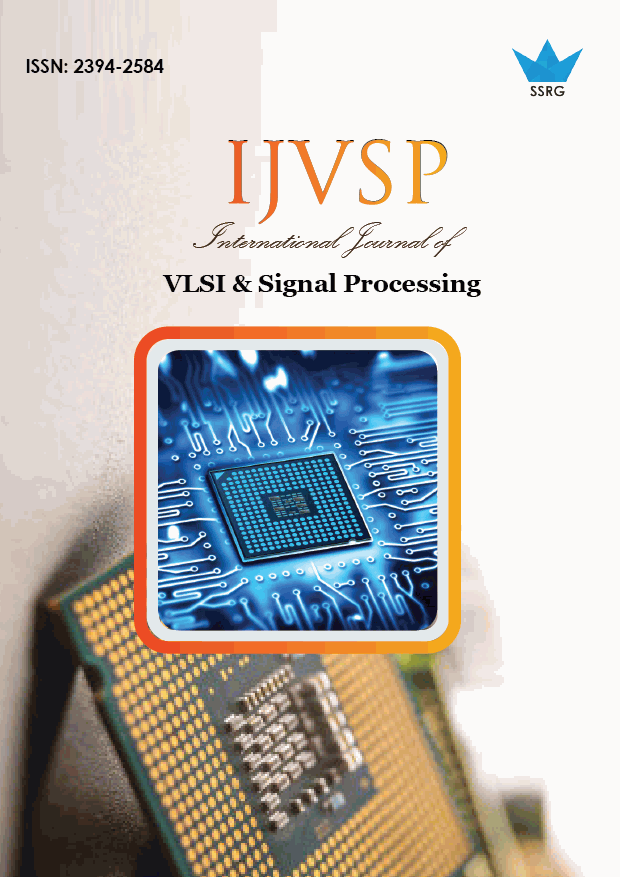High Performance and Low Power Asynchronous Data Sampling with Power Gated Double Edge Triggered Flip-Flop

| International Journal of VLSI & Signal Processing |
| © 2015 by SSRG - IJVSP Journal |
| Volume 2 Issue 1 |
| Year of Publication : 2015 |
| Authors : R. Aruna and S.Thenappan |
How to Cite?
R. Aruna and S.Thenappan, "High Performance and Low Power Asynchronous Data Sampling with Power Gated Double Edge Triggered Flip-Flop," SSRG International Journal of VLSI & Signal Processing, vol. 2, no. 1, pp. 9-12, 2015. Crossref, https://doi.org/10.14445/23942584/IJVSP-V2I1P103
Abstract:
Power consumption and energy efficiency is a major role in sequential circuit design. Power gating is a technique that is used to reduce the static power consumption of idle modules. Usage of Dual Edge Triggered Flip-flop (DETFF) is an efficient technique since it consumes the clock frequency and less power than Double Edge Triggered Flip-flops (DETFF’s). Integrating power gating technique with DETFF reduces the power consumption and leakage power further, but it leads to asynchronous data sampling problem. In this paper, two methods have been used to eradicate the asynchronous data sampling problem and their power analysis has been estimated. In order to reduce the leakage power consumption further, a new design has proposed for a DETFF. Based on his new design, the two methods have been implemented using 130 μm Tanner EDA tool.
Keywords:
Double Edge Trigger Flip Flop, Clock Gating, Power Gating, Single Edge trigger Flip Flop
References:
[1] M. Keating, D. Flynn, R. Aitken, A. Gibbons, and K. Shi, Low Power Methodology Manual: For System-on-Chip Design. New York: Springer, 2007.
[2] M. Pedram, “Power minimization in IC design: Principles and applications,” ACM Trans. Design Autom. Electron. Syst. (TODAES), vol. 1, no. 1, pp. 3–56, 1996.
[3] V. Venkatachalam and M. Franz, “Power reduction techniques for microprocessor systems,” ACM Comput. Surveys (CSUR), vol. 37, no. 3, and 2005.
[4] C.-C. Yu, “Low-power double edge-triggered flip-flop circuit design,” in Proc. Int. Conf. Innovative Computing Information and Control (ICICIC), 2008.
[5] A. G.M. Strollo, C. Cimino, and E. Napoli, “Power dissipation in onelatch and two-latch double edge triggered flip-flops,” in Proc. IEEE Int. Conf. Electronics, Circuits and Systems, 1999, vol. 3, pp. 1419–1422.
[6] R. Hossain, L. Wronski, and A. Albicki, “Low power design using double edge triggered flip-flops,” IEEE Trans. Very Large Scale Integr. (VLSI) Syst., vol. 2, no. 2, pp. 261–265, 1994.
[7] A. G. M. Strollo, E. Napoli, and C. Cimino, “Analysis of power dissipation in double edge-triggered flip-flops,” IEEE Trans. Very Large Scale Integr. (VLSI) Syst., vol. 8, no. 5, pp. 624–629, Oct. 2000.
[8] N. Nedovic and V. G. Oklobdzija, “Dual-edge triggered storage elements and clocking strategy for low-power systems,” IEEE Trans. Very Large Scale Integr. (VLSI) Syst., vol. 13, no. 5, pp. 577–590, Oct. 2005.
[9] V. Stojanovic and V. G. Oklobdzija, “Comparative analysis of master slave latches and flip-flops for high-performance and low-power systems,” IEEE J. Solid-State Circuits, vol. 34, no. 4, pp. 536–548, Apr. 1999.
[10] K.-H. Cheng and Y.-H. Lin, “A dual-pulse-clock double edge triggered flip-flop for low voltage and high speed application,” in Proc. IEEE Int. Symp. Circuits and Systems (ISCAS), 2003, vol. 5, pp. 425–428.
[11] K. Inoue and M. Kaneko, “Variable-duty-cycle scheduling in doubleedge- triggered flip-flop-based high-level synthesis,” in Proc. IEEE Int. Symp. Circuits and Systems (ISCAS), 2011, pp. 550–553.
[12] P. Zhao, J. McNeely, P. Golconda, M. A. Bayoumi, R. A. Barcenas, and W. K. W. Kuang, “Low-power clock branch sharing double-edge triggered flip-flop,” IEEE Trans. Very Large Scale Integr. (VLSI) Syst., vol. 15, no. 3, pp. 338–345, Jun. 2007.

 10.14445/23942584/IJVSP-V2I1P103
10.14445/23942584/IJVSP-V2I1P103